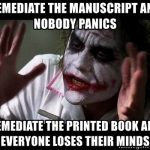Reading through Module 4 I could not help but draw parallels with my present situation in my classroom teaching. A key question to ask is how are electronic structures modifying our views of the way in which knowledge is ordered and utilized? The impact that hypertext has had had on education is undeniable and it has already transformed how our students are storing and displaying their learning everyday in our classrooms. An increasing important part of my journey through the year with my students is their construction of a digital portfolio. A webspace to keep track of and organize their work as they progress through their various subjects throughout the year. 15 years ago portfolios consisted of students having a physical folder with much of their years work within it. Yet website building platforms such as wix or wordpress have completely changed this path and the advent of hypertext has transformed our notion of text. Bolter states “A hypertext consists of topics and their connections, where the topics may be paragraphs, sentences, individual words, or indeed digitized graphics and segments of video” (Bolter, 2001, p. 24)
The idea behind my students creating these digital portfolios is to allow them to view their learning journey as a formative series of events, a continuum. “All the individual pages may be of equal importance in the whole text, which becomes a network of interconnected writings” (Bolter, 2001, p. 20) The portfolio’s provide a virtual space in which the students can push far outside the physical limitations of the pen and paper. They can display their work in video, audio and text and more importantly link and move between their ideas seamlessly and concurrently. They can then look back on their work, reflect on their mistakes and move towards adapting and changing their ideas for future endeavours. Kess touches on the idea of digital natives grasp of hypertext and its implications “Children who grow up using ThinkTank, or a program like it, may develop the capacity to handle large amounts of information, and to structure it at an early age. Thus, they may be able to solve problems more effectively than their elders.” (Kamin,1984, p. 218) I have no recollection or artifacts from my elementary or high school years which I can look back on or draw from or relish. All I can remember are a series of separate courses that were placed into specified subject areas with no regard given to documenting the journey or reflecting on it. Our students can interconnect ideas reflect on and problem solve in ways that we never had access to.
My students learning journey is not linear, nor is it neat and organized. Learning is a messy process that contains connections and interconnections that weave and thread through all subject areas. Yet our education system has tried to compartmentalize knowledge into specified subject areas that define what areas of learning are. I have for years asked our students digital spaces to be split between science, socials, french etc, yet this year I started to meld the subjects together, drawing connections between subjects. This is where I enjoyed reading Bolters definition of writing spaces “We have a writing space that is not only topical; we might even call it “topographic.”(Bolter, 2001, p. 24) He defines hypertexts space as a series of elevation gains and losses. “It is not the writing of a place, but rather a writing with places as spatially realized topics.”(Bolter, 2001, p. 24) My students socials project on the coast Salish people that involves a google map, images and text can be linked through hypertext into their science project that tracks the dwindling salmon population in BC oceans. Hypertext allows for connections between subjects that breaks down the structured barriers that compartmentalizes learning in our schools
All of this requires a teacher, a guide to help them build, organize and synthesize within this digital realm. “As more connections are made, the possibility for contradiction increases. This is the paradox of all self-engulfing and centreless systems.” (Keep, Connections without Centre: Infinite Hypertext, Para 3) Randomly throwing ones ideas on a webpage and connecting them through links is a recipe for disaster. An understanding of how to utilize the affordances of hypertext is where a teacher can provide wisdom through years of practice with knowledge structures and linkages. Hypertext has transformed our traditional system “curriculum and teaching tend to be defined in terms of mastery of and engagement with dominant modes of information”(Luke, 2003, p.397) This new medium is no doubt becoming the dominant mode of information. I ponder what Kress asks “ Would the next generation of children actually be much more attuned to truth through the specificity of depiction rather than the vagueness of word?” (Kress, 2005, p.21) The answer to this is in our classrooms today.
References
Bolter, J. D. (2001). Writing space: Computers, hypertext, and the remediation of print. Routledge.
Kamin, J. (1984). The Think Tank Book. Berkeley, CA: Sybex.
Keep, C., McLaughlin, T., & Parmar, R. (1995). “Re-thinking the book.” The electronic labyrinth. Available: http://jefferson.village.virginia.edu/elab/elab.html (Links to an external site.)Links to an external site.
Kress, Gunter. (2005). “Gains and losses: New forms of texts, knowledge and learning. Computers and Composition. 22(1), 5-22.Retrieved, August 15, 2009, from http://dx.doi.org/10.1016/j.compcom.2004.12.004 (Links to an external site.)Links to an external site.
Luke, C. (2003). Pedagogy, Connectivity, Multimodality, and Interdisciplinarity. Reading Research Quarterly, 38(3), 397-403.



george backhouse
August 10, 2018 — 1:06 pm
I thoroughly enjoyed reading your post. You make a number of very salient points. What I found particularly interesting, is your commitment to the use of a digital portfolio to enhance the classroom learning experience. Like you, I have no evidence of the learning that occured when I was at school. It would have been nice to return to some of my work in subsequent years. I would love to see how my thoughts and ideas have changed. I agree with your estimation that reflecting on learning is where the meaningful learning takes place.
I have found that students are very open to the idea of a digital learning portfolio. They enjoy the challenges of filling it and personalizing it. However, as you suggest, they do need some guidance and support in the process. I teach a language. In language learning it is sometimes beneficial for students to compose by hand. With pen or pencil on paper. The physical process of writing reinforces learning and appears to enhance the brain’s capacity to recall a particular word.
However, we have experimented with digital portfolios and found them to be tremendously beneficial in other ways. Firstly, it encourages individualism. Students appear to enjoy the challenge of illustrating and maintaining their portfolios. This in turn encourages students to take pride in their work. More so than when they design a paper-based portfolio. A digital portfolio is also more interactive. Students can add photos, videos and sound bites. This is not possible on a paper-based medium.
Finally, I find my frustration heightened when I have to sift through a student’s portfolio to find how their contribution links to a common thread or subject. I guess this is simply due to the nature of associative thinking. It appears that you have already embraced this chaos. It is something to which I am only beginning to grow accustomed. Their work is always very creative and it is clear to me that they put a tremendous amount of effort into it. However, they still need the teacher to help them establish clear connections between the disparate pieces of their work and the overall theme.
(Word count: 357)